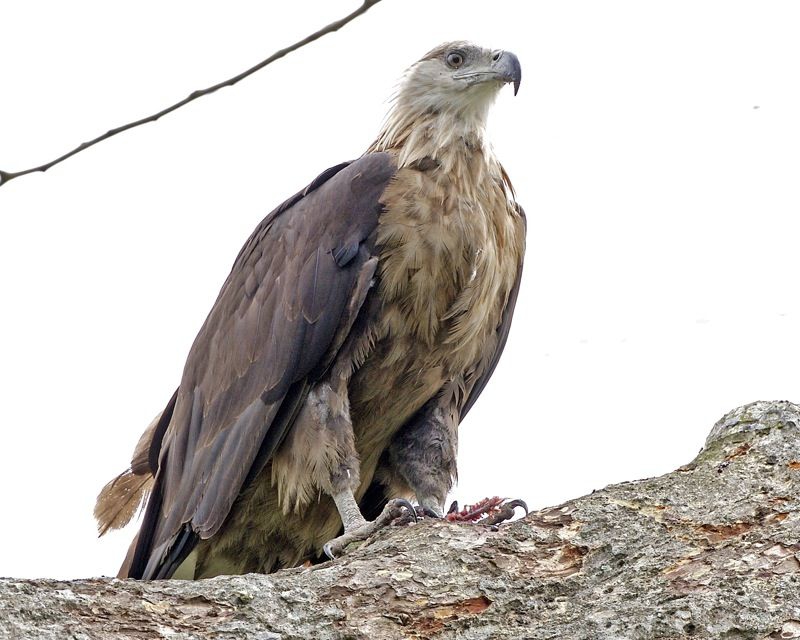| Citation |
|
Description |
Geographic Range [top]
Range Description: Haliaeetus leucoryphus occurs across a huge range from Kazakhstan (may no longer breed, although a positive trend has been noted in the number of records since the late 1990s at least [Kovalenko 2009]), southern Russia (possibly still breeds), Tajikistan, Turkmenistan (probably dispersing non-breeders) and Uzbekistan, east through Mongolia and China, south to northern India, Pakistan, Bhutan, Bangladesh and Myanmar. It is a passage migrant and winter visitor to Nepal and non-breeding visitor to Afghanistan. The main breeding populations are believed to be in China, Mongolia and the Indian subcontinent. Surveys in Mongolia in June-August 2009 produced observations of a minimum total of 20 birds at eight locations (Gilbert and Gombobataar 2009). It is believed to have declined significantly during the 20th century in China, Pakistan, India, Nepal and Bangladesh. The population is likely to number fewer than 10,000 mature individuals.
Countries occurrence:
Native:
Afghanistan; Bangladesh; Bhutan; China; India; Iran, Islamic Republic of; Kazakhstan; Kyrgyzstan; Mongolia; Myanmar; Nepal; Pakistan; Russian Federation; Tajikistan; Turkmenistan; Uzbekistan
Vagrant:
Cambodia; Finland; Iraq; Israel; Netherlands; Norway; Oman; Saudi Arabia; Ukraine; United Arab Emirates
Continuing decline in area of occupancy (AOO): Yes
Extreme fluctuations in area of occupancy (AOO): No
Estimated extent of occurrence (EOO) - km2: 3010000
Continuing decline in extent of occurrence (EOO): Yes
Extreme fluctuations in extent of occurrence (EOO): No
Number of Locations: 11-100
Continuing decline in number of locations: Unknown
Extreme fluctuations in the number of locations: No
Upper elevation limit (metres): 5000
Range Map: Click here to open the map viewer and explore range.
Population [top]
Population: The global population is estimated to number < c.10,000 mature individuals (by BirdLife International 2001) based on detailed analysis of available records, while the population in China has been estimated at c.100-10,000 breeding pairs (Brazil 2009). It is placed in the band 2,500-9,999 mature individuals, equivalent to 3,750-14,999 individuals in total, rounded here to 3,500-15,000 individuals.
Trend Justification: A moderate and on-going population decline is suspected on the basis of rates of loss, degradation and disturbance of wetland habitats and adjacent nesting trees throughout its range.
Current Population Trend: Decreasing
Additional data:
?Number of mature individuals: 2500-9999 ?Continuing decline of mature individuals: Yes
?Extreme fluctuations: No ?Population severely fragmented: No
?No. of subpopulations: 1 ?Continuing decline in subpopulations: Unknown
?Extreme fluctuations in subpopulations: No ?All individuals in one subpopulation: Yes
?No. of individuals in largest subpopulation: 100
Habitat and Ecology [top]
Habitat and Ecology: It is closely associated with wetlands, principally large lakes and rivers, from the lowlands to 5,000 m. It generally nests in trees near water.
Systems: Terrestrial; Freshwater
Continuing decline in area, extent and/or quality of habitat: Unknown
Generation Length (years): 17.2
Movement patterns: Full Migrant
Threats [top]
Major Threat(s): Key threats are habitat loss, degradation and disturbance. Across the Indian subcontinent, and probably most of its range, wetlands have been drained or converted for agriculture and human settlements. The felling of large trees near wetlands has reduced the availability of nest and roost sites. The spread of water hyacinth Eichhornia crassipes is a problem in India, as is the siltation of lakes due to catchment deforestation. Pollution of wetlands with pesticides and industrial effluents reduces breeding success. Habitat loss and degradation are compounded by disturbance of wetlands. Reductions in the prey base, primarily through hunting and over-fishing, are further consequences of increasing human pressure. In Myanmar, the development of oil and gas fields is a threat and, in China, hunting is a localised problem. In Mongolia, during surveys in summer 2009, it was noted that two recently completed hydroelectric dams were severely disrupting water levels in the affected drainage basins and could potentially affect all sites where the species occurs in the Great Lake Basin (Gilbert and Gombobataar 2009). Over-fishing was also noted at several sites and low rainfall was leading to falling water levels in some areas (Gilbert and Gombobataar 2009).
Conservation Actions [top]
Conservation Actions: Conservation Actions Underway
CITES Appendix II, CMS Appendix II. It occurs in many protected areas across its range such as Corbett, Kaziranga and Manas, India and Chitwan, Nepal.
Conservation Actions Proposed
Carry out research into the speciess breeding ecology (Gilbert and Gombobataar 2009). Conduct surveys in central Asia and Myanmar to establish its status, distribution and threats. Establish protected areas for key populations. Encourage sustainable management of wetland resources. Limit the use of pesticides and control of industrial discharges around wetlands. Control water hyacinth at important breeding/feeding sites. Protect remaining nest-trees and re-establish them around wetlands. Protect nest-sites (and adjacent feeding sites) from disturbance. Promote rural education programmes concerned with wetland birds. Study the impact of hydroelectric dam projects, such as those in Mongolia (e.g. Gilbert and Gombobataar 2009), and monitor the levels of pesticide residues in prey species to indicate whether further measures are required (A. Rahmani in litt. 2012). Conduct research into the speciess ecology and behaviour (A. Rahmani in litt. 2012) and carry out satellite tracking to study the speciess movements (Gilbert and Gombobataar 2009).
Citation: BirdLife International. 2014. Haliaeetus leucoryphus. The IUCN Red List of Threatened Species 2014: e.T22695130A62641957. http://dx.doi.org/10.2305/IUCN.UK.2014-2.RLTS.T22695130A62641957.en. Downloaded on 08 June 2016.
Disclaimer: To make use of this information, please check the .
Feedback: If you see any errors or have any questions or suggestions on what is shown on this page, please provide us with feedback so that we can correct or extend the information provided |

